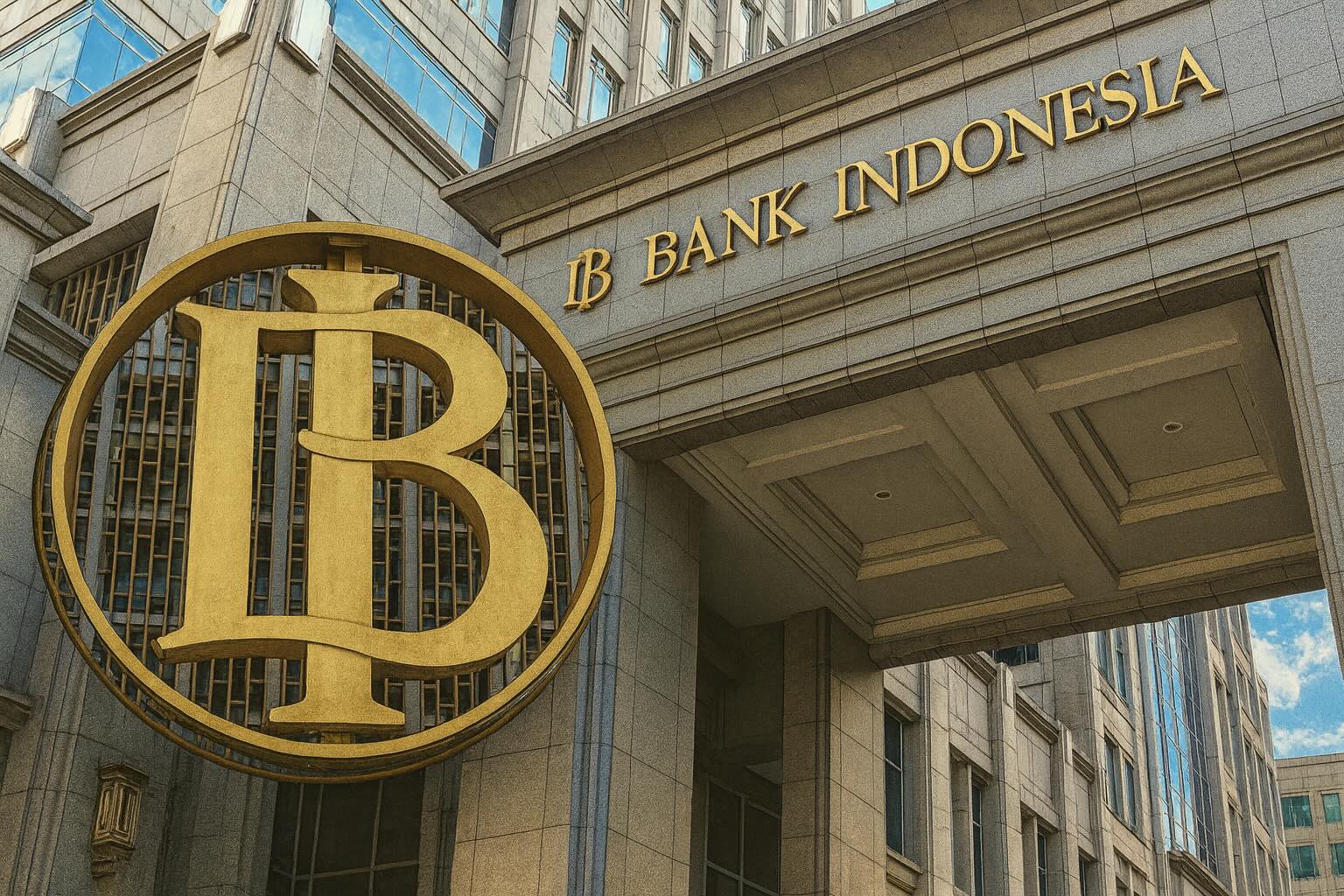- Central Bank Defies Forecasts: Indonesia’s central bank unexpectedly held its benchmark interest rate at 4.75% at the October policy meeting, surprising markets that widely anticipated a cut to 4.50% [1]. It was the first pause after three consecutive rate reductions [2], upending the expectations of 21 out of 28 economists in a Reuters poll [3].
- Rationale – Inflation Low, Rupiah Stability: Governor Perry Warjiyo cited the need to maintain low inflation (currently ~2.65%, well within the 1.5–3.5% target) and currency stability amid global uncertainty as key reasons for standing pat [4]. Warjiyo stressed that while there is “still room for rate cuts,” the focus now is on strengthening monetary policy transmission and working in synergy with the government to support growth [5] [6].
- Market Reaction – Stocks Swoon, Rupiah Rises: The surprise hold jolted financial markets. Jakarta’s Composite Index (JCI) fell ~1.0% on the news, ending a bank stock rally that had been fueled by rate-cut hopes [7] [8]. Indonesia’s big bank shares, which surged 6–8% earlier in the week on easing bets [9] [10], reversed course – Bank Central Asia sank 3.2%, Bank Rakyat Indonesia -1.6%, and Bank Mandiri -0.5% by Wednesday’s close [11]. Property stocks, however, jumped ~3%, as investors took heart from government incentives and the prospect that lower rates (when they come) will eventually spur real estate demand [12]. The rupiah currency strengthened slightly after the decision [13], a welcome relief given it had depreciated about 3% this year despite recent central bank intervention [14].
- Economists Split – Growth vs. Currency:Analysts were divided ahead of the decision on whether Bank Indonesia (BI) should cut rates again in October. Many urged another 25 bps cut to 4.5% to bolster slowing growth, noting vehicle sales and exports have weakened and inflation is subdued [15] [16]. Others warned that too many cuts could imperil the rupiah and financial stability, especially with the currency among Asia’s weakest in 2025 [17] [18]. BI’s recent easing cycle – 150 bps of cuts since late 2024 – has been a balancing act between supporting growth and guarding the rupiah [19] [20], and Wednesday’s pause underscores the bank’s cautious approach to that trade-off. “Bank Indonesia was expected to hold rates steady… prioritizing currency stability,” one market commentary noted, reflecting the central bank’s concerns over exchange-rate volatility [21].
- Outlook – Further Easing Likely (Politics Permitting): Experts generally see this pause as temporary, with more rate relief on the horizon. Capital Economics argues BI’s focus on policy transmission signals a dovish bias, predicting three more rate cuts to ~4.0% by early 2026 [22]. A Reuters poll median likewise expects the benchmark down to 4.25% by year-end (from 4.75% now) and staying low through 2026 [23]. However, political pressures and BI’s independence remain wildcards. President Prabowo Subianto’s new administration has set an ambitious 8% GDP growth target, far above Indonesia’s ~5% trend [24], and top officials are pressing for looser policy. Finance Minister Purbaya Yudhi Sadewa (who replaced long-time minister Sri Mulyani Indrawati in a recent cabinet shake-up) openly suggested that if inflation holds at ~2.5%, “BI must be forced to slowly reduce the benchmark rate to 3.5%” in order to cut borrowing costs and keep Indonesian businesses competitive [25] [26]. Economists caution that while inflation is tame and growth could use a boost, “bowing to political pressure” by easing too aggressively might undermine central bank credibility and stoke longer-term risks [27].
Central Bank Shocks Markets by Holding Rates Steady
Indonesia’s central bank sprang a surprise on October 22 by keeping its key interest rate unchanged at 4.75%, defying widespread expectations of a rate cut. This decision – announced at the conclusion of Bank Indonesia’s Board of Governors meeting – caught markets off guard, as most forecasters had penciled in a fourth consecutive cut. Economists polled before the meeting overwhelmingly predicted a 25 basis-point reduction to 4.50% [28]. In fact, a Wall Street Journal survey found six out of seven economists expected a cut, given the benign inflation backdrop and efforts to spur growth [29]. Instead, BI opted to pause its easing cycle, a move Governor Perry Warjiyo acknowledged was contrary to market bets [30].
“We still see room for rate cuts, but our focus now is on strengthening the effectiveness of monetary policy transmission,” Governor Warjiyo explained, emphasizing that the central bank wants to assess the impact of previous easing before moving again [31]. He noted the decision was “consistent with [our] expectations of low inflation” – currently 2.6% year-on-year – “and our mandate to maintain currency stability amid global uncertainty.” In other words, with inflation well within target and the rupiah under pressure, BI chose to hit the brakes on rate cuts to ensure stability [32].
This surprise hold comes after an aggressive streak of monetary loosening. Since September 2024, BI has slashed its benchmark rate by 150 bps in total, including cuts at each of the past three meetings [33] [34]. As a result, borrowing costs are at their lowest since 2022 [35]. These moves were aimed at jump-starting economic growth in Southeast Asia’s largest economy, which, while resilient, has shown signs of cooling. Second-quarter GDP growth hit 5.1% (a two-year high) thanks to post-pandemic pent-up demand [36], but recent indicators signal a loss of momentum – vehicle sales have slipped, export growth has slowed, and consumer confidence has softened [37] [38]. With inflation subdued at 2.65% (comfortably inside BI’s 1.5–3.5% target range) [39], pressure was building on BI to keep cutting rates to prop up domestic demand.
Yet, offsetting those growth concerns is a delicate issue: the Indonesian rupiah. The currency has been one of Asia’s weakest performers in 2025, down roughly 3% against the U.S. dollar year-to-date [40]. A series of BI interventions in FX markets helped the rupiah regain some ground in early October [41], but officials remain wary of further depreciation. Each rate cut can encourage capital outflows and weaken the currency – a dangerous prospect when the rupiah’s stability is legally part of BI’s mandate [42]. “In Indonesia, [the central bank] was expected to hold rates steady… prioritizing currency stability,” observed a TS² financial markets analysis, underscoring that BI’s calculus is heavily influenced by the rupiah’s fate [43]. Indeed, Warjiyo has repeatedly stressed the need to “go all out” to support growth while maintaining financial market stability” [44] [45], signaling a constant balancing act between boosting the economy and defending the currency.
By pausing in October, BI tilted toward caution, at least for now. Warjiyo indicated that further rate cuts are not off the table, but will depend on how effectively previous cuts are feeding through to the real economy and credit markets [46]. He also highlighted BI’s strategy of “strengthening [the] policy mix” in coordination with the government’s fiscal measures to ensure growth is shored up by more than just low interest rates [47]. In fact, BI’s statement referenced plans to intensify policy synergy with the government – a nod to recent moves like fiscal incentives for property buyers and accelerated budget spending to stimulate activity [48] [49]. Warjiyo expects full-year 2025 GDP growth to come in slightly above 5% (the midpoint of BI’s 4.6–5.4% forecast range), and to strengthen further in 2026, assuming supportive policies continue [50].
Stocks Surge Then Slump as Investors Digest the News
Going into this week, investors had been betting on another rate cut – and positioning accordingly. In the days ahead of the policy meeting, Indonesia’s stock market enjoyed a rally, led by its banking sector. On Monday (Oct 20), shares of the nation’s four largest banks jumped 6–8% in a single session [51] [52], anticipating a dovish outcome from BI. Bank Negara Indonesia surged 7.6% by midday Monday, while peers Bank Mandiri, Bank Central Asia (BCA), and Bank Rakyat Indonesia (BRI) all climbed over 6% [53] [54]. Analysts noted the rate-cut consensus had “raised hopes” for a broader stock rally, expecting cheaper credit to boost economic activity and corporate earnings [55] [56]. The Jakarta Composite Index (JCI) had just come off a 4.1% weekly decline [57], so the prospect of monetary stimulus was seen as a catalyst for a year-end rebound in equities.
However, when the central bank broke the script by holding rates, the market’s reaction pivoted sharply. The Jakarta benchmark tumbled immediately after the announcement, ultimately closing down 1.04% on Wednesday [58]. Bank stocks, which had been euphoria-induced outperformers, suddenly led the decline. BCA – Indonesia’s largest bank – saw its stock fall over 3% on the day, erasing much of its pre-meeting gains [59]. BRI dropped 1.6%, and Bank Mandiri slipped about 0.5% [60]. This swift reversal effectively “ended [the] bank stock rally” that had begun earlier in the week [61].
Investors’ disappointment was rooted in the notion that an expected tailwind (lower interest costs) didn’t materialize. Banking sector profits, for instance, often benefit from lower central bank rates because funding costs decline and loan demand can rise. The surprise hold prompted a rethink of those short-term bullish assumptions. Trading volumes spiked on Wednesday as funds quickly unwound positions; total market turnover hit IDR 23.1 trillion (≈$1.5 billion) for the day, well above average [62].
There was, however, a silver lining for some sectors. Property developers and real-estate linked stocks actually climbed after the BI decision, bucking the market trend [63]. The IDX Property Index jumped ~3%, led by big developers like Pantai Indah Kapuk Dua and Jaya Sukses Makmur which each rallied on Wednesday [64]. Counterintuitively, the absence of a rate cut did not dent property shares – likely because this sector had already been buoyed by other government measures. Analysts pointed out that Jakarta’s extension of a VAT incentive for housing purchases through 2027 is providing strong support to real estate companies’ sales outlook [65]. Moreover, many in the property market still expect borrowing costs to come down eventually, even if BI paused this month, which would reduce mortgage rates. “With [the VAT] incentive, developers can maintain their sales performance,” explained Nurwachidah, a research analyst at Phintraco Sekuritas, adding that the policy backdrop remains favorable for property demand [66].
On the currency front, the rupiah staged a modest relief rally. The Indonesian currency strengthened slightly against the dollar after BI’s announcement [67]. A stable or rising rupiah suggests traders interpreted the hold as a sign the central bank is serious about defending the currency. By standing pat on rates (rather than cutting and potentially undercutting yield differentials), BI instilled a bit more confidence in the rupiah, which has struggled in recent months. It helped that the rupiah had already been shored up by BI’s market interventions earlier in October – efforts that contributed to a partial rebound from its lows [68]. Still, the rupiah remains roughly 3% weaker against the dollar in 2025, making it an outlier laggard while many emerging-market peers benefited from a softer greenback [69] [70]. This context explains why BI is treading carefully: if the rupiah were to slide too far, it could fuel import inflation and prompt capital outflows, a scenario the central bank is keen to avoid. Wednesday’s decision, therefore, sent an implicit message that exchange-rate stability is taking priority in the near term, even at the cost of a short delay in monetary stimulus.
Notably, Indonesia is not alone in this balancing act – other emerging markets are also weighing domestic rate cuts against currency implications. In the lead-up to BI’s meeting, global investors were also watching the U.S. Federal Reserve and other major central banks. A TS² TechStock financial brief observed that worldwide, an “ultra-dovish” outlook had propelled a $15 trillion stock rebound, but lingering “rate jitters” made some Asian markets skittish about policy surprises [71] [72]. That turned out to be prescient in Indonesia’s case: a policy surprise did arrive, and it injected volatility into local markets. As one fund manager quipped, “central banks are the new market makers – and sometimes heart-breakers”, underlining how BI’s move briefly rattled investor sentiment.
Growth Ambitions vs. Currency Fears: Why BI Hit Pause
The drama around this rate decision shines a spotlight on a broader debate: How far and fast should Indonesia push monetary easing? On one side are concerns about economic growth – the need to stimulate credit, spending, and investment to keep the recovery on track. On the other side are concerns about financial stability – chiefly the rupiah’s value, capital flows, and the central bank’s credibility. BI’s October pause shows it is trying to strike a prudent balance amid these cross-currents.
Economic growth in Indonesia has been respectable but not spectacular. Quarterly GDP gains around 5% are solid by global standards, yet officials argue the economy could and should grow faster. President Prabowo Subianto, who took office earlier this year, has set an ambitious goal of 7–8% annual growth in the coming years – a pace Indonesia hasn’t seen in decades. To chase that target, the government is leaning on all levers of policy. This includes fiscal stimulus (such as infrastructure spending and tax breaks) and, pointedly, monetary policy easing to lower borrowing costs.
In fact, the pressure on Bank Indonesia to support growth has become overt. Just days before the latest BI meeting, Indonesia’s new Finance Minister Purbaya Yudhi Sadewa made headlines by effectively calling for deeper interest rate cuts. Purbaya, a former economist who replaced long-time technocrat Sri Mulyani, stated that if inflation can be anchored at 2.5%, “Bank Indonesia should be able to lower its benchmark rate to 3.5%” – a full 125 basis points below today’s level [73] [74]. He emphasized that lower rates would help Indonesian businesses compete with regional rivals like Malaysia, noting “if interest rates here are too high, our companies cannot compete” [75] [76]. While Purbaya tempered his comment by acknowledging the government “could not control the central bank”, he also remarked that by keeping inflation low through sound policies, “BI would have to reduce rates” as a logical consequence [77].
Such remarks are unusually direct – essentially a public nudge from the fiscal authority to the monetary authority. They underscore the political desire for looser financial conditions. It’s worth noting that BI has a dual mandate akin to many central banks: controlling inflation and ensuring the stability of the rupiah, while also supporting sustainable economic growth. Traditionally, BI has been viewed as cautious and independent, focusing on price stability first. But the narrative seems to be shifting under the new administration, which places a premium on accelerating growth.
On the flip side, many economists urge caution, warning that too much, too fast in rate cuts could backfire. Indonesia has been through periods of currency turmoil in the past (the late-1990s Asian Financial Crisis and the 2013 “Taper Tantrum” are seared into policymakers’ memories). Even recently, the rupiah’s underperformance has raised eyebrows. By mid-September, it was down ~2% for the year and had earned the title of “worst performing currency in emerging Asia”, despite a broadly weaker U.S. dollar environment [78] [79]. Capital Economics analyst Gareth Leather cautioned last month that BI’s “clear pivot towards growth-supportive measures” – evidenced by its surprise rate cuts in August and September – “risks undermining confidence in policymaking” [80]. If investors suspect the central bank is prioritizing short-term growth over its core stability goals, they could demand a risk premium for Indonesian assets or even pull money out, which would weaken the rupiah and raise borrowing costs in the longer run. “That said, the government and central bank’s pivot… could force BI to reconsider its dovish stance if markets react adversely,” Leather warned after BI’s September cut [81]. In effect, there’s a fine line: stimulus should not come at the expense of market trust.
Another issue is Bank Indonesia’s independence and mandate, which have been subjects of growing debate. Recently, a “burden-sharing” arrangement was instituted, requiring BI to fund some government debt for development programs [82]. Additionally, Parliament has been discussing amendments to the BI Act that would expand the central bank’s role in supporting growth and increase legislative oversight of monetary policy [83]. Draft provisions even consider giving parliament the power to recommend the removal of the central bank governor under certain conditions [84]. These developments worry analysts. “If policy easing continues and turns out more aggressive than expected, it inevitably raises fears officials are bowing to political pressure,” noted Jason Tuvey, deputy chief EM economist at Capital Economics [85]. He and others argue that BI must guard its credibility. The October pause, in a sense, may help counter the narrative that BI is simply yielding to government demands. By defying expectations for a cut, Warjiyo demonstrated a degree of independence – showing that BI will not cut rates at every meeting just because it can. Indeed, Tuvey observed that Wednesday’s hold “may ease concerns over the central bank’s independence amid government pressure for looser policy”, even as he remains mindful of the risk that politics could push BI into larger cuts down the road [86].
For now, BI insists that current monetary settings are compatible with both objectives: inflation and rupiah stability on one hand, and adequate support for growth on the other. Warjiyo has pointed out that inflation is projected to stay within target through 2026 [87] [88], giving room for policy ease, but that BI’s recent rate cuts need time to permeate the economy. He highlighted that bank lending rates have not fallen as much as they should – as of September, banks had only passed on 7 bps of rate reductions to borrowers, a tiny fraction of the 150 bps BI cut from its benchmark [89]. This suggests a transmission problem: liquidity was ample, but credit growth was tepid because banks were reluctant to lend or borrowers were hesitant to take loans [90]. In fact, in Q3 the finance ministry moved IDR 190 trillion (~$12.5 billion) of government funds from BI to commercial banks specifically to encourage lending [91]. Warjiyo welcomed that move and a new $1 billion fiscal stimulus package for Q4 [92], acknowledging that monetary and fiscal coordination is key to boosting demand without upsetting markets [93]. The central bank appears to be saying: let’s make sure previous rate cuts are actually working (i.e., banks lend more, businesses borrow and invest) before we add more cuts.
What’s Next: Will Cuts Resume, and How Will Markets Cope?
The big question following this surprise hold is, what comes next? Most analysts do believe that Bank Indonesia’s easing cycle isn’t over – it’s just been delayed or drawn out. In Governor Warjiyo’s own words, BI still sees “room for rate cuts” ahead [94]. The consensus view is that once conditions allow, BI will likely trim rates further, possibly as soon as the next meeting or two. The central bank itself did not characterize the hold as the end of easing, but rather a pause to evaluate and “monitor the effectiveness” of its policies and the outlook for inflation, growth, and the rupiah [95].
Forecasts vary on timing, but not on direction:
- Capital Economics expects another 75 bps of rate cuts by early 2026, taking BI’s policy rate down to 4.00% from the current 4.75% [96]. Their view hinges on inflation remaining subdued and authorities becoming more confident that the rupiah can weather additional easing. With global oil prices relatively low and domestic food supply stable, Indonesia’s inflation has been remarkably mild (under 3% and near historic lows), bolstering the case for lower interest rates.
- The Reuters poll (conducted Oct 13–20) showed a median expectation for the policy rate to fall to 4.25% by end-2025, implying at least one if not two quarter-point cuts in the next few months [97]. Notably, that survey was taken before the latest decision; many of those economists assumed a cut in October plus perhaps another in December. Given the hold, some may revise their calls – but the end-point forecast of 4.25% suggests analysts still anticipate BI will ease a bit more to support the economy. The poll also predicted the rate would then stay at 4.25% throughout 2026 [98], reflecting a view that BI will likely pause once it reaches a moderately accommodative stance and then wait to see if faster growth materializes.
- From the market’s perspective, local banks and investors had largely priced in a cut this week and were looking for more. For example, Bank Permata’s economists, following September’s surprise cut, revised their outlook to expect BI 7-day repo at 4.50% by end-2025 (vs. 4.75% prior) and further reductions in 2026 [99]. That is essentially betting that BI would deliver two more 25 bp cuts after September – a script now partially delayed by the October pause. It wouldn’t be surprising if some forecasters now push that timeline out (e.g. 4.50% by early 2026 instead of December 2025).
- Importantly, external factors will heavily influence BI’s next moves. Several analysts have pointed out that Indonesia’s leeway to cut rates increases if U.S. interest rates start falling. “Policymakers likely bet on a re-widening in the Indo-U.S. rate differential after the Fed’s anticipated cut this week, providing more headroom to lower domestic rates in Q4,” observed Radhika Rao of DBS Bank in mid-September [100]. In other words, if the U.S. Federal Reserve were to cut its rates (as many expected around October 2025, amid signs of a U.S. slowdown), the yield gap between Indonesia and the U.S. would widen, taking pressure off the rupiah. This scenario would give BI cover to ease without fear of making Indonesian assets relatively unattractive. At the time of writing, global markets indeed are forecasting Fed rate reductions in late 2025 [101]. BI’s pause could simply be a timing maneuver: waiting for the Fed to move first. “Given the uncertain domestic growth outlook and external risks, especially from U.S. policy, [I] expect BI to resume rate cuts in early 2026,” said Kevin Khaw Khai Sheng of iFast Capital, “assuming a firmer rupiah on a weaker dollar, with the central bank prioritizing financial stability over aggressive stimulus.” [102] This encapsulates the conditional nature of BI’s future path – the direction is likely downward (more easing), but the pace depends on currency stability and global conditions.
- Another variable is how domestic financial markets continue to react. The equity market’s brief tantrum after the rate hold might seem to argue for delivering the cut next time to avoid spooking investors. But one could also interpret it as a sign that BI’s credibility remains intact – the drop was modest (just 1% on the index) and not a panic. If anything, it showed investors were surprised but not panicked, which could embolden BI to act on its own terms. Over the medium term, lower interest rates should be a positive for stocks, especially rate-sensitive sectors like property, banking (in terms of loan growth), and consumer discretionary companies. The key is ensuring that any easing doesn’t come at the cost of financial instability. So far, stock market participants appear to still believe in BI’s balancing act; after the initial knee-jerk selloff, the market stabilized and attention shifted back to corporate earnings and other drivers.
Looking ahead, it’s clear that Bank Indonesia is navigating a narrow path. The central bank is attempting to nurture a growing economy to higher altitude, without upsetting the delicate equilibrium of inflation expectations and currency confidence. The October policy twist – holding rates steady when virtually everyone expected a cut – highlights BI’s cautious stance in the face of uncertainty.
Indonesia’s fundamentals give reasons for optimism: growth around 5%, inflation under control, and a government eager to implement pro-growth policies. These conditions typically warrant accommodative monetary policy. And indeed, more easing is likely on the way, as most experts concur. But BI is showing it wants to pace the journey. By surprising markets now, Warjiyo and his board signaled that they won’t chase short-term market approval at the expense of longer-term stability.
For businesses and the public, the central bank’s move may have near-term implications: loan and mortgage rates might not fall as quickly as hoped this quarter, but they are still near multi-year lows after the recent cuts. The rupiah’s steadiness, if maintained, should keep imported inflation (fuel, food) in check, which is good for consumers. If BI resumes trimming rates in the coming months, as forecast, borrowers and firms will eventually get the benefit. It might just happen a bit later than expected.
In the bigger picture, Indonesia’s policy mix in 2025 is a story of cautious calibration. The government’s push for growth is running up against the central bank’s mandate to ensure stability. How well policymakers manage this trade-off will not only determine interest rate policy, but could also influence investor confidence and Indonesia’s financial trajectory going forward. As of now, BI has chosen to pause and evaluate, a move that has provoked intense discussion but also perhaps prevented potential overheating. The coming months will reveal whether this patience pays off – if growth holds up and inflation stays low, BI’s prudence will look prescient. If growth sputters badly without further stimulus, the chorus for bolder action will grow louder.
Either way, one lesson from this episode is clear: never underestimate a central bank’s ability to surprise. Investors have been reminded that even in an era of forward guidance and polls, monetary authorities can and will break from expectations to achieve their objectives. Indonesia’s central bank did just that – and in doing so, it has set the stage for an interesting end to the year in Indonesian markets, with all eyes on the next move of Perry Warjiyo and team. [103] [104]
Sources: Wall Street Journal/Dow Jones Newswires [105] [106]; Reuters [107] [108]; Jakarta Globe; IDN Financials [109] [110]; TS² Finance/TechStock [111]; TradingView/Refinitiv [112] [113].
References
1. www.idnfinancials.com, 2. www.morningstar.com, 3. www.reuters.com, 4. www.morningstar.com, 5. www.idnfinancials.com, 6. www.morningstar.com, 7. www.idnfinancials.com, 8. www.idnfinancials.com, 9. www.idnfinancials.com, 10. www.idnfinancials.com, 11. www.idnfinancials.com, 12. www.idnfinancials.com, 13. www.morningstar.com, 14. www.reuters.com, 15. www.reuters.com, 16. www.reuters.com, 17. www.reuters.com, 18. www.reuters.com, 19. www.reuters.com, 20. www.reuters.com, 21. ts2.tech, 22. www.morningstar.com, 23. www.reuters.com, 24. www.reuters.com, 25. www.tradingview.com, 26. www.tradingview.com, 27. www.reuters.com, 28. www.reuters.com, 29. www.morningstar.com, 30. www.idnfinancials.com, 31. www.idnfinancials.com, 32. www.morningstar.com, 33. www.morningstar.com, 34. www.reuters.com, 35. www.reuters.com, 36. www.reuters.com, 37. www.reuters.com, 38. www.reuters.com, 39. www.reuters.com, 40. www.reuters.com, 41. www.reuters.com, 42. www.reuters.com, 43. ts2.tech, 44. www.reuters.com, 45. www.reuters.com, 46. www.morningstar.com, 47. www.morningstar.com, 48. www.idnfinancials.com, 49. www.idnfinancials.com, 50. www.morningstar.com, 51. www.idnfinancials.com, 52. www.idnfinancials.com, 53. www.idnfinancials.com, 54. www.idnfinancials.com, 55. www.idnfinancials.com, 56. www.idnfinancials.com, 57. www.idnfinancials.com, 58. www.idnfinancials.com, 59. www.idnfinancials.com, 60. www.idnfinancials.com, 61. www.idnfinancials.com, 62. www.idnfinancials.com, 63. www.idnfinancials.com, 64. www.idnfinancials.com, 65. www.idnfinancials.com, 66. www.idnfinancials.com, 67. www.morningstar.com, 68. www.reuters.com, 69. www.reuters.com, 70. www.reuters.com, 71. ts2.tech, 72. ts2.tech, 73. www.tradingview.com, 74. www.tradingview.com, 75. www.tradingview.com, 76. www.tradingview.com, 77. www.tradingview.com, 78. www.reuters.com, 79. www.reuters.com, 80. www.reuters.com, 81. www.reuters.com, 82. www.reuters.com, 83. www.reuters.com, 84. www.reuters.com, 85. www.reuters.com, 86. www.morningstar.com, 87. www.tradingview.com, 88. www.tradingview.com, 89. www.reuters.com, 90. www.reuters.com, 91. www.reuters.com, 92. www.reuters.com, 93. www.reuters.com, 94. www.idnfinancials.com, 95. www.morningstar.com, 96. www.morningstar.com, 97. www.reuters.com, 98. www.reuters.com, 99. www.reuters.com, 100. www.reuters.com, 101. ts2.tech, 102. www.morningstar.com, 103. www.idnfinancials.com, 104. www.morningstar.com, 105. www.morningstar.com, 106. www.morningstar.com, 107. www.reuters.com, 108. www.reuters.com, 109. www.idnfinancials.com, 110. www.idnfinancials.com, 111. ts2.tech, 112. www.tradingview.com, 113. www.tradingview.com









